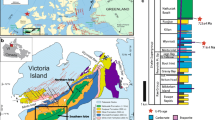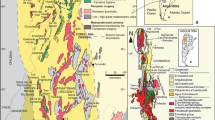Abstract
Fuji volcano is the largest active volcano in Japan, and consists of Ko-Fuji and Shin-Fuji volcanoes. Although basaltic in composition, small-volume pyroclastic flows have been repeatedly generated during the Younger stage of Shin-Fuji volcano. Deposits of those pyroclastic flows have been identified along multiple drainage valleys on the western flanks between 1,300 and 2,000 m a.s.l., and have been stratigraphically divided into the Shin-Fuji Younger pyroclastic flows (SYP) 1 to 4. Downstream debris flow deposits are found which contain abundant material derived from the pyroclastic flow deposits. The new14C ages for SYP1 to SYP4 are 3.2, 3.0, 2.9, and 2.5 ka, respectively, and correspond to a period where explosive summit eruptions generated many scoria fall deposits mostly toward the east. The SYP1 to SYP4 deposits consist of two facies: the massive facies is about 2 m thick and contains basaltic bombs of less than 50 cm in size, scoria lapilli, and fresh lithic basalt fragments supported in an ash matrix; the surge facies is represented by beds 1 to 15 cm thick, consisting mainly of ash with minor amount of fine lapilli. The bombs and scoria are 15 to 30% in volume within the massive facies. The ashes within the SYP deposits consist largely of comminuted basalt lithics and crystals that are derived from the Middle-stage lava flows exposed at the western flanks. SYP1 to SYP4 were only dispersed down the western flanks. The reason for this one-sided distribution is the asymmetric topography of the edifice; the western slopes of the volcano are the steepest (over 34 degrees). Most pyroclastic materials cannot rest stably on the slopes steeper than 33 degrees. Therefore, ejecta from the explosive summit eruptions that fell on the steep slopes tumbled down the slopes and were remobilized as high-temperature granular flows. These flows consisted of large pyroclastics and moved as granular avalanches along the valley bottom. Furthermore, the avalanching flows increased in volume by abrasion from the edifice and generated abundant ashes by the collision of clasts. The large amount of the fine material was presumably available within the transport system as the basal avalanches propagated below the angle of repose. Taking the typical kinetic friction coefficient of small pyroclastic flows, such flows could descend the western flanks where scattered houses are below 1,000 m a.s.l. A similar type of pyroclastic flow could result if explosive summit eruptions occur in the future.












Similar content being viewed by others
Reference
Bagnold RA (1956) The flow of cohesionless grains in fluids. Proc R Soc Lond Ser A 249:235–297
Boudon G, Camus G, Gourgaud A, Lajoie J (1993) The 1984 nuee-ardente deposits of Merapi volcano, Central Java, Indonesia: stratigraphy, textural characteristics, and transport mechanisms. Bull Volcanol 55:327–342
Campbell CS, Cleary PW, Hopkins M (1995) Large-scale landslide simulations: global deformation, velocities and basal friction. J Geophys Res 100 (B5):8267–8283
Davis DK, Quaerry MW, Bonis SB (1978) Glowing avalanches from the 1974 eruption of the volcano Fuego, Guatemala. Geol Soc Am Bull 89:369–384
Denlinger RP (1987) A model for generation of ash clouds by pyroclastic flows, with application to the 1980 eruptions at Mount St. Helens, Washington. J Geophys Res 92(B1O):10284–10298
Drake TG (1990) Structural features in granular flows. J Geophys Res 95(B6):8681–8696
Hazlett RW, Buesch D, Anderson JL, Elan R, Scandone R (1991) Geology, failure conditions, and implications of seismogenic avalanches of the 1944 eruption at Vesuvius, Italy. J Volcanol Geothermal Res 47:249–264
Ishida M, Hatano H, Shirai T (1980) The flow of solid particles in an aerated inclined channel. Powder Tecnol 27:7–12
Iwatsuka S, Machida H (1962) The development of Osawa Valley, Mt Fuji: the fundamental study on the development of radial valleys on Volcano (in Japanese with English abstract). J Geogr 71:143–158
Izumi K, Kigoshi K, Uesugi Y, Endo K, Harada S, Kojima Y, Kikuhara K (1977) Short Note on the Holocene Tephra Formation around the Eastern Flank of Fuji Volcano (in Japanese with English abstract). Quat Res 16:87–90
Koyama M (1998) Reevaluation of the eruptive history of Fuji volcano, Japan, mainly based on historical documents (in Japanese with English abstract). Bull Volcanol Soc Jpn 43:323–347
Lajoie J, Boudon G, Bourdier JL (1989) Depositional mechanics of the 1902 pyroclastic nuee-ardente deposits of Mt. Pelee, Martinique. J Volcanol Geotherm Res 38:131–142
Lowe DR (1976) Grain flow and gain flow deposits. J Sediment Petrol 46:188–199
Lowe DR (1982) Sediment gravity flows: II. positional models with special reference to the deposits of high-density turbidity currents. J Sediment Petrol 52:279–297
Machida H (1964) Tephrochronological study of Volcano Fuji and adjacent areas (in Japanese with English abstract). J Geogr 73:293–308,337–350
Machida H (1977) Tephra: its characteristics and relationship to the Japanese Quaternary Era (in Japanese). Shojushobo, Tokyo, 324 pp
McGetchin TR, Settle M, Chouet BA (1974) Cinder cone growth modeled after Northeast crater, Mount Etna, Sicily. J Geophy Res 79:3257–3272
Miyagi I (2002) Gradient map of Japan (in Japanese with English abstract). Open-file Report, Geol Surv Jpn 378
Miyaji N (1984) Wild effect on the dispersion of the Fuji 1707 tephra (in Japanese with English abstract). Bull Volcanol Soc Jpn 29:17–30
Miyaji N (1988) History of Younger Fuji Volcano (in Japanese with English abstract). J Geol Soc Jpn 94:433–452
Moore JG, Melson WG (1969) Nuees ardentes of the 1968 eruption of Mayon volcano, Philippines. Bull Volcanol 33:600–620
Nairn IA, Self S (1978) Explosive eruptions and pyroclastic avalanches from Ngauruhoe in February 1975. J Volcanol Geotherm Res 3:39–60
Nakamura K (1977) Volcanoes as possible indicators of tectonic stress orientation. J Volcanol Geotherm Res 2:1–16
National Land Agency (1992) Guideline for producing volcanic hazard prediction maps (in Japanese). National Land Agency, Jpn, 153 pp
Postma G (1986) Classification for sediment gravity-flow deposits based on flow conditions during sedimentation. Geology 14:291–294
Saucedo R, Macias JL, Bursik M (2004) Pyroclastic flow deposits of the 1991 eruption of Volcan de Colima, Mexico. Bull Volcanol 66:291–306
Shimada S (2000) Eruption of the Amagi-Kawagodaira volcano and paleo-environments in the Late and Latest Jomon Periods around the Izu Peninsula (in Japanese with English abstract). Quat Res 39:151–164
Shimokawa K, Yamazaki H, Mizuno K, Imura R (1996) 1995 fiscal year active fault research report No.27. Paleoseismological study of the Fujikawa fault system by excavation survey and all-core drilling (in Japanese with English abstract). Open-file Report, Geol Surv Jpn 251:49
Takahashi M, Hasegawa Y, Tsukui M, Nemoto Y (1991) Evolution of magma-plumbing system beneath Fuji volcano: on the viewpoint of whole-rock chemistry (in Japanese with English abstract). Bull Volcanol Soc Jpn 36:281–296
Takarada S, Kazahaya K, Kawanabe Y, et al. (1993) Volume estimation of 1991–1992 eruption of Unzen volcano, and initiation mechanisms of pyroclastic flows on June 3 and June 8, 1991 (in Japanese with English abstract). Bull Geol Surv Jpn 44:11–24
Togashi S, Miyaji N, Yamazaki H (1991) Fractional crystallization in a large tholeiitic magma chamber during the Early Stage of the Younger Fuji Volcano, Japan (in Japanese with English abstract). Bull Volcanol Soc Jpn 36:269–280
Tsuya H (1938) Geological and petrological studies of Volcano Fuji, II: distribution of the Aokigahara lava (in Japanese with English abstract). Bull Earthq Res Inst, Tokyo Univ 14:638–657
Tsuya H (1940) Geological and petrological studies of Volcano Fuji, III: geology of the southwestern foot of the Volcano Fuji (in Japanese with English abstract). Bull Earthq Res Inst, Tokyo Univ 18:419–445
Tsuya H (1955) Geological and petrological studies of Volcano Fuji, V: on the 1707 eruption of Volcano Fuji. Bull Earthq Res Inst, Tokyo Univ 33:341–383
Tsuya H (1962) Geological and petrological studies of Volcano Fuji, VI: geology of the volcano as observed in some borings on its flanks. Bull Earthq Res Inst, Tokyo Univ 40:767–804
Tsuya H (1968) Geology of Volcano Mt. Fuji. Explanatory text of geologic map 1:50,000 scale. Geol Surv Jpn, 24 pp
Tsuya H (1971) Topography and geology of Volcano Mt. Fuji: results of the co-operative Scientific Survey of Mt. Fuji (in Japanese with English abstract) Fuji Kyuko Co. Ltd., Tokyo, 127 pp
Uesugi Y, Endo K, Harada S, Kojima Y, Izumi K (1979) Unconformable relations in the Holocene tephra formation around the northern and eastern flanks of the Fuji volcano, Japan (in Japanese with English abstract). Quat Res 17:207–214
Ui T, Matsuwo N, Sumita M, Fujinawa A (1999) Generation of block and ash flows during the 1990–1995 eruption of Unzen Volcano, Japan. J Volcanol Geotherm Res 89:123–137
Ukawa M (2002) Low-frequency earthquakes, volcanic eruption prediction and hazard mitigation (in Japanese). Chikyuu Monthly 269:784–790
Wood CA (1980) Morphometric analysis of cinder cone degradation (in Japanese with English abstract). J Volcanol Geotherm Res 8:137–160
Woods AW, Kienle J (1994) The dynamics and thermodynamics of volcanic clouds: theory and observations from the April 15 and April 21, 1990 eruptions of Redoubt Volcano, Alaska. J Volcanol Geotherm Res 62:273–299
Yamamoto T, Takarada S, Suto S (1993) Pyroclastic flows from the 1991 eruption of Unzen volcano, Japan. Bull Volcanol 55:166–175
Yamamoto T, Nakamura Y, Glicken H (1999) Pyroclastic density current from the 1888 phreatic eruption of Bandai volcano, NE Japan. J Volcanol Geotherm Res 90:191–207
Acknowledgments
This study stems from the 1:50,000 quadrangle mapping project of the Geological Survey of Japan, AIST. Hidenori Endo and Hirohisa Matsuura, the former and present group leaders of the project, worked on all aspects of the research program. Discussions with Shigeo Aramaki, Toshitugu Fujii, Kozo Uto, Masato Koyama, Tatsuro Chiba and Masaaki Hanaoka are much appreciated. We also thank E Calder, A Duncan and G Giordano and for helpful reviews of the manuscript
Author information
Authors and Affiliations
Corresponding author
Additional information
Editorial responsibility: R Cioni
Rights and permissions
About this article
Cite this article
Yamamoto, T., Takada, A., Ishizuka, Y. et al. Basaltic pyroclastic flows of Fuji volcano, Japan: characteristics of the deposits and their origin. Bull Volcanol 67, 622–633 (2005). https://doi.org/10.1007/s00445-004-0398-y
Received:
Accepted:
Published:
Issue Date:
DOI: https://doi.org/10.1007/s00445-004-0398-y




